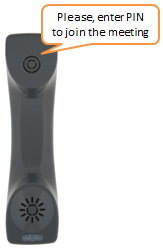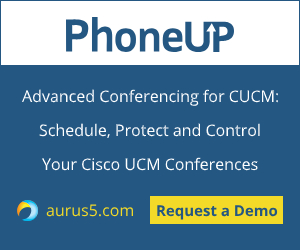- "How to configure Meet-Me video conference with PIN?"
- "We need to configure Meet-Me conference with PIN…"
- "CUCM 10.x Meet-Me with Name announcement and Pin number…"
- try to search the Cisco Support Forum and you'll get dozens of similar tickets.
Yes, the built-in Meet-Me conferencing feature doesn't support PIN authentication, so here goes the list of all possible ways to set it up.
Before we start, let's agree that we only consider Cisco Unified Communications Manager Enterprise or Cisco BE 6000/7000. If you've got CUCM/CallManager Express (CME) you can play with TCL IVR scripts, but that’s definitely another story.
So you're enjoying Cisco UCM Meet-Me conferencing, but you want attendees to hear the voice prompt asking for a PIN needed to join the meeting. You’ve got 4 options:
1. Cisco Unity Express/Connection
If you have Cisco Unity deployed you can use it to achieve the Meet-Me authentication. The attendees call should be transferred via CUC and the User System Transfer Conversation should be used to authenticate the caller (a user is created on CUC). The conversation prompts the caller to sign in to CUC with his CUC ID and PIN and then transfers the call to Meet-Me conference number.
Looks like a kludge? Still it gets the job done.
2. Cisco Unified Contact Center Express (UCCX)
You can use UCCX as an audio front end to Meet-Me conferences. You may find several UCCX scripts around the web which prompt the caller for meeting ID and password and then transfer the call to the MeetMe bridge. Meeting IDs and PINs are set up by UCCX admin.
This works, but since UCCX is used for something that it’s not initially designed for, this workaround isn’t as feature-rich as you users may require and hard to maintain.
3. The "Conference Now" feature of CUCM 11
The "Conference Now" feature is introduced in Cisco UCM v.11 released in the summer of 2015. It's not the replacement for Meet-Me feature, but allows users to create their personal conference rooms protected (optionally) by the access code. The attendee has to call your conference room number, enter the access code and listen to the music until you start the meeting by joining it.
Quite promising feature but the access code stays the same until you change it, so if I participated in your meeting once, I can use it to join the next time even if I wasn’t invited. Also, no scheduler and conference control tool are available.
4. The “Conference” module of “Aurus PhoneUP” suite
The CUCM Meet-Me conferencing solution from Aurus is designed specifically for CUCM conferencing and allows you to:
- schedule Meet-Me conferences with a web-interface;
- use the MS Outlook plugin to schedule the meetings from the Outlook calendar;
- use the same phone number for meetings (the PIN entered is used to define which meeting you're joining);
- protect meetings with a randomly generated PIN (the PIN is automatically added to the meeting invitation sent to invitees);
- control the conference with the web-interface – the meeting host can see the list of participants, join a new attendee and disconnect anyone;
- start the meeting from any phone - without the necessity to use a Cisco IP phone to initiate the meetme bridge;
- control the resources of the conference bridge.

So, these are 4 options to secure your Meet-Me conferences. Which one works better for you, depends on your business requirements and Cisco products used. Hopefully, this article will help you to evaluate the pros and cons of each option in relation to your environment.


